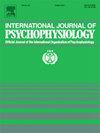Exploring difference in recognition and confusion of facial expressions between high and low problematic internet use individuals: Evidence from behavior and ERPs
IF 2.6
3区 心理学
Q3 NEUROSCIENCES
引用次数: 0
Abstract
Accurate recognition of facial expressions is crucial for effective interpersonal socialization, but individuals with problematic internet use (PIU) may face challenges. This study compared facial expression recognition between high PIU (HPIU) and low PIU (LPIU) individuals across three experiments. Experiment 1, using six-alternative forced choice task, found that HPIU individuals recognized six basic emotions significantly less accurately than LPIU individuals and showed greater confusion, particularly for negative expressions. Experiment 2 focused on anger and disgust expressions using the emotional expression multimorph task. HPIU individuals made significantly more errors for both expressions. Experiment 3, using event-related potentials (ERPs), revealed HPIU individuals exhibited higher N170 amplitude to anger at early stages. Additionally, HPIU individuals demonstrated higher aggression, emotional social isolation, state-trait anxiety, and immature defense styles. Correlation analysis showed that after FDR correction, only aggression levels (and its subscales) correlated significantly with facial expression recognition task performance. These findings offer initial insights into PIU-related facial expression recognition differences and highlight aggression as a key psychosocial correlate. Observed trends in specific facial expression recognition area warrant further investigation.
探究高、低问题上网个体在面部表情识别和混淆方面的差异:来自行为和erp的证据。
面部表情的准确识别对于有效的人际交往至关重要,但网络使用问题个体可能面临挑战。本研究通过三个实验比较了高PIU (HPIU)和低PIU (LPIU)个体的面部表情识别。实验1采用六选项强迫选择任务,发现高piu个体对六种基本情绪的识别准确率明显低于低piu个体,并表现出更大的困惑,尤其是对消极表达。实验二采用情绪表达多变形任务研究愤怒和厌恶的表情。HPIU个体对这两种表达的错误明显更多。实验3利用事件相关电位(ERPs)发现,高收入者在早期阶段对愤怒表现出较高的N170振幅。此外,高智商个体表现出更高的攻击性、情绪性社会孤立、状态-特质焦虑和不成熟的防御风格。相关分析显示,经过FDR校正后,只有攻击性水平(及其子量表)与面部表情识别任务表现显著相关。这些发现提供了与piu相关的面部表情识别差异的初步见解,并强调攻击性是关键的社会心理关联。观察到的特定面部表情识别领域的趋势值得进一步研究。
本文章由计算机程序翻译,如有差异,请以英文原文为准。
求助全文
约1分钟内获得全文
求助全文
来源期刊
CiteScore
5.40
自引率
10.00%
发文量
177
审稿时长
3-8 weeks
期刊介绍:
The International Journal of Psychophysiology is the official journal of the International Organization of Psychophysiology, and provides a respected forum for the publication of high quality original contributions on all aspects of psychophysiology. The journal is interdisciplinary and aims to integrate the neurosciences and behavioral sciences. Empirical, theoretical, and review articles are encouraged in the following areas:
• Cerebral psychophysiology: including functional brain mapping and neuroimaging with Event-Related Potentials (ERPs), Positron Emission Tomography (PET), Functional Magnetic Resonance Imaging (fMRI) and Electroencephalographic studies.
• Autonomic functions: including bilateral electrodermal activity, pupillometry and blood volume changes.
• Cardiovascular Psychophysiology:including studies of blood pressure, cardiac functioning and respiration.
• Somatic psychophysiology: including muscle activity, eye movements and eye blinks.

 求助内容:
求助内容: 应助结果提醒方式:
应助结果提醒方式:


